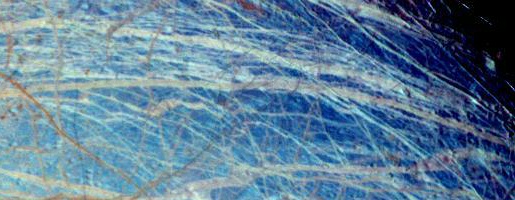 |
|||
|
False-colour
image showing ice plains (blue) and linea (reddish).
|
|||
| THE SURFACE OF EUROPA | |||
| Pictures of Europa's terminator (the edge of the moon's disk) show that the terrain is very smooth and has very little topography. The highest features are only 200 metres to 300 metres above the surface. This makes Europa one of the smoothest bodies in the Solar System. | |||
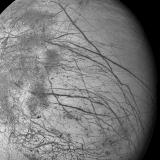 Europa's northern hemisphere as seen by Galileo |
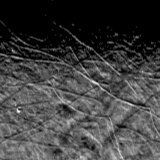 Europa's evening terminator shows a flat surface |
||
| There are two main terrain types on Europa. Bright plains make up most of the surface and give Europa a high albedo. With an overall albedo of 0.64, Europa is the most reflective of Jupiter's moons. There are also darker mottled plains which are brownish in colour. | |||
 Europa colour view, showing the darker, brown plains. |
|||
| Both bright and dark terrains are cut by a labyrinth of criss-crossing lines. The dark lines are up to 40 kilometres across and can be several thousand kilometres long. There are also bright ridges. The ridges tend to be narrower and shorter than the dark bands. They are typically 10 kilometres across and run for distances approaching 100 kilometres. | |||
 Thera and Thrace Macula. |
 Belus Linea and Mannannán crater. |
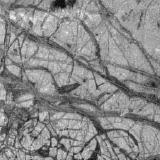 Europa's equatorial zone. |
|
| A number of special names are used to describe the surface features of Europa. Lineae are the bright or dark elongated markings which can be straight or curved. Flexus is the name given to a bright curved ridge with a wave pattern. They are estimated to be in the region of 100 metres to 200 metres high. The origin of these scalloped ridges is uncertain. They don't appear to be related to any other surface features as they simply cut across the dark bands. Nor does their alignment yield any clue to how they formed.Maculae are dark patches with diffuse or fuzzy edges. Some of these have an irregular shape, but others are roughly circular and may result from impact cratering. | |||
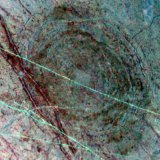 Tyre, a possible impact crater. |
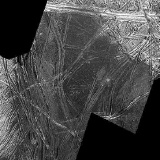 A dark deposit - remnant of a fluid. |
||
| More about Europa's craters | |||
| Tectonics | |||
| The most immediately striking aspect of the surface of Europa is the tangle of dark intersecting lines. These suggest that the dominant processes on Europa are tectonic, relating to the movement of the surface. | |||
| The dark and light linear features occurring all over Europa are seen at a variety of scales. Some of the dark lines are over 3,000 kilometres in length and form a global network, but closer examination shows progressively finer linear features. These are interpreted as forming as the surface splits apart and the gaps are filled with a dirty mixture of slush and debris from below. | |||
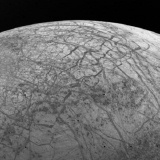 Voyager 2 image of Europa's western hemisphere. |
 Details of ice floes and fractures |
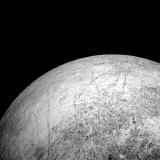 Europa's leading hemisphere. |
|
| High resolution Galileo images show complex ridges that form patterns resembling those made by rapidly freezing water. It is possible to see which ridges are younger by the way they overlap or cut though other ridges. Though quite a complex task, the sequence of ridge formation can be worked out. This may tell scientists whether or not surface processes on Europa have changed in style and maybe even how the structure of the lithosphere has changed over time. | |||
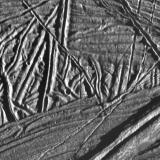 Sets of fractures next to a double ridge. |
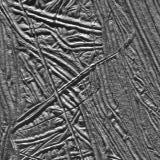 Crosscutting ridges and fractures |
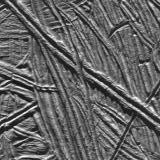 Direction changes amongst the ridges. |
|
| One theory is that ridges are formed along older fracture lines. Periodic changes in Europa's crust, caused by Jupiter's gravity, could explain why many of the ridges appear parallel to one another. The ridges that formed in a different direction represent a different epoch of Europa's geological history, showing that the forces have changed direction through time. | |||
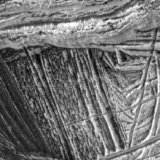 Separation of the crust followed by freezing of water. |
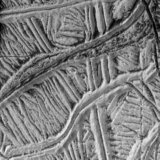 Close-up view of double ridges. |
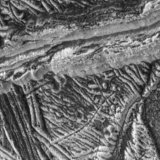 Brighter areas show evidence of frost. |
|
| The ridge material has different spectral characteristics to the surrounding terrain, which shows up clearly when colour is used. The ridge material may be richer in mineral salts, left behind by the evaporation of water that has welled up from Europa's interior. Spectral analysis of the darker areas of Europa has led to various chemicals being suggested, for example, natron (Na2CO), hexahydrite (MgSO4.6H2O), and epsomite (MgSO4.7H2O). | |||
 High resolution image of a double ridge. |
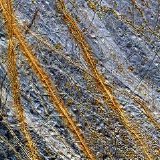 Different colours represent different surface chemistry. |
||
| It can be seen that the forces at work on the surface of Europa have been responsible for a great deal of structural change. These forces have effectively resurfaced Europa, in the process destroying the ancient historical record. | |||
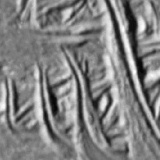 Rotated ridges in Cyclades Macula are evidence of changing forces. |
|||
| Some of the dark bands on Europa are wedge shaped, while others are rectangular or diamond shaped. These show how the surface of Europe has cracked and moved apart. In some places sections of the surfaces have moved away from each other directly. In other places, wedges show how pieces of crust rotate into a new position. Further evidence of movement can be seen in the displacement of older cracks. The movement of plates, though small by terrestrial standards, are the closest Solar System analogue to plate tectonics on Earth. | |||
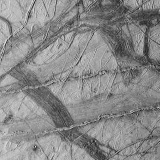 Wedges on Europa show similarities to terrestrial tectonics. |
 Close-up view (left) of Astypalaea Linea. |
 The wedge represents a fracture that has been subsequently filled. |
|
| Since there are cracks, features caused by extension, there ought to be corresponding compression features. These could not be identified in Voyager images with certainty though it was thought that the bright flexus features were formed by buckling of the clean surface ice. It is not certain though what produces the stresses and drives the movement of the surface. Tidal forces might be directly responsible for splits in the surface. Alternatively heating of the interior by tidal forces causes the water layer to convect. This could drive plate tectonics, like the convecting mantle on Earth. On Europa though, the plates are simply jostled about and not recycled. | |||
| Triple bands | |||
| A class of linear feature first seen in Voyager pictures appears frequently in Galileo images. 'Triple bands' comprise a bright centre band with a pair of dark strips either side. They are typically 6 kilometres across, with ridges about 180 metres high. More detailed mages show that the triple bands themselves have a complex system of ridges on their surface. | |||
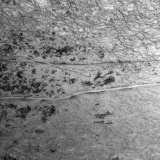 Agenor Linea, a typical triple band. |
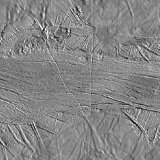 Close-up view of Agenor Linea, revealing complex ridge structure. |
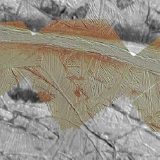 Varying surface chemistry across the Agenor Linea triple band. |
|
| Triple bands are thought to have formed by the surface splitting apart. This allowed dark liquid to ooze out in a long line which froze quickly to make the dark ridge. The bright central band was formed by the upwelling of clean water. | |||
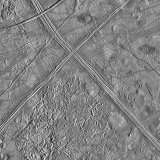 Wide-angle view of the Agenor Linea triple band. |
 Agenor Linea composition - brown areas represent evaporites. |
||
| The dark outside edges of some triple bands, those of Belus Linea for example, have diffuse edges. Some investigators think that this might be caused by linear ice volcanoes ejecting gas and fine rocky silicate debris from Europa's interior. The central band was then put in place by a steadier flow of purer water ice, giving it a more solid edge. | |||
 Belus Linea and Mannannán crater. |
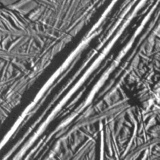 Triple band structure, a possible source of active geysers. |
||
| Ice rafts | |||
| There are numerous fragments or rafts of ice embedded in the surface of Europa. The old surface appears to have been broken up then re-frozen. The icebergs are usually quite small but they can be up to 30 kilometres across. | |||
 Conamara Chaos ice rafts, white areas are Pwyll crater ejecta. |
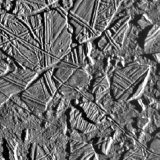 Ice raft details, showing similarities to Earth's pack ice. |
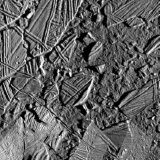 Conamara Chaos ice rafts. |
|
| Apart from criss-crossing ridges formed before the break up of the surface, they are quite smooth. Many of the surfaces between the ice-floes though are quite rugged and appear to have formed from slushy ice rather than a runny liquid. This slushy ice probably contains rocky material as well. | |||
| Volcanism | |||
| Several features on the surface of Europa appear to have a volcanic origin. Some Galileo images show clusters of hills and low domes. The domes are as large as 9 kilometres across but are generally about 5 kilometres to 6 kilometres in diameter. They are about 500 metres high. In places they deform ridges that were already on the surface, which indicates that they evolved later and are relatively youthful features. | |||
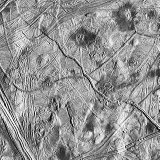 Hills and domes altering already emplaced features. |
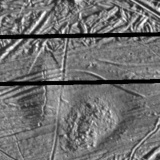 A possible volcanic dome, caused by underwater upwelling. |
||
| Around some of the domes are dark splodges of material which some researchers say could have erupted from vents in the domes. It is possible that there were no eruptions and that the hills are produced by volcanic activity which makes the surface dome upwards. In which case the hills made by plumes of low density ice forcing its way to the surface. These work in the way hotspots on Venus do where light material rises though the lithosphere, not piercing the surface layer, but simply pushing it upwards to form a dome. | |||
 Mounds and depressions, surface signs of subsurface activity. |
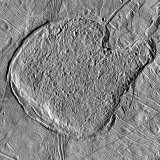 Liquid water melting through the surface and freezing. |
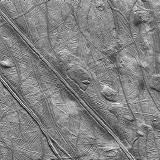 Dome-shaped volcanic features. |
|
| In some Galileo images, very smooth regions can be seen. These featureless areas appear to have been made by a fluid which seeped onto surface, flooding the older more complex ridges and grooves. Smooth patches such as these may have formed like maria on the Moon, but from warm water rather than molten rock. | |||
| Ice cliffs and hills | |||
| Although the Europan surface is smooth when compared to other Solar System objects, it still has its cliffs and hills. However, Europan hills only reach a height of up to 300 metres. At the base of some cliffs can be seen debris that has broken off and fallen into the valleys. | |||
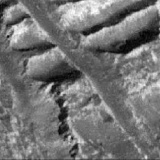 300 metre high ice cliffs in the Conamara Chaos region. |
 Conamara Chaos ice cliffs showing fallen debris. |
 Highest resolution image of Europa. |
|
| Isolated mountains can also be found in Galileo images - such mountains are made of ice. At a height of 250 metres, ice mountains are amongst the tallest features of the landscape. That such a small feature is classified as a mountain demonstrates why Europa is likened to a billiard ball. | |||
| False colour images | |||
| False colour images have been used to study the composition and differences in the types of ice present on the surface. Composite images are made using violet, green and infrared images to enhance subtle differences in the true colour of the surface. In false colour images dark brown areas are dirty and rock contaminated materials from the deeper within the surface, possibly excavated by impact cratering. Different shades of blue identify regions of coarse-grained ice, whereas light blue areas distinguish fine-grained ice. | |||
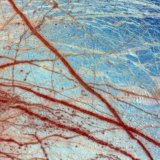 False-colour image showing ice plains (blue) and linea (red). |
|||
|
|
|||